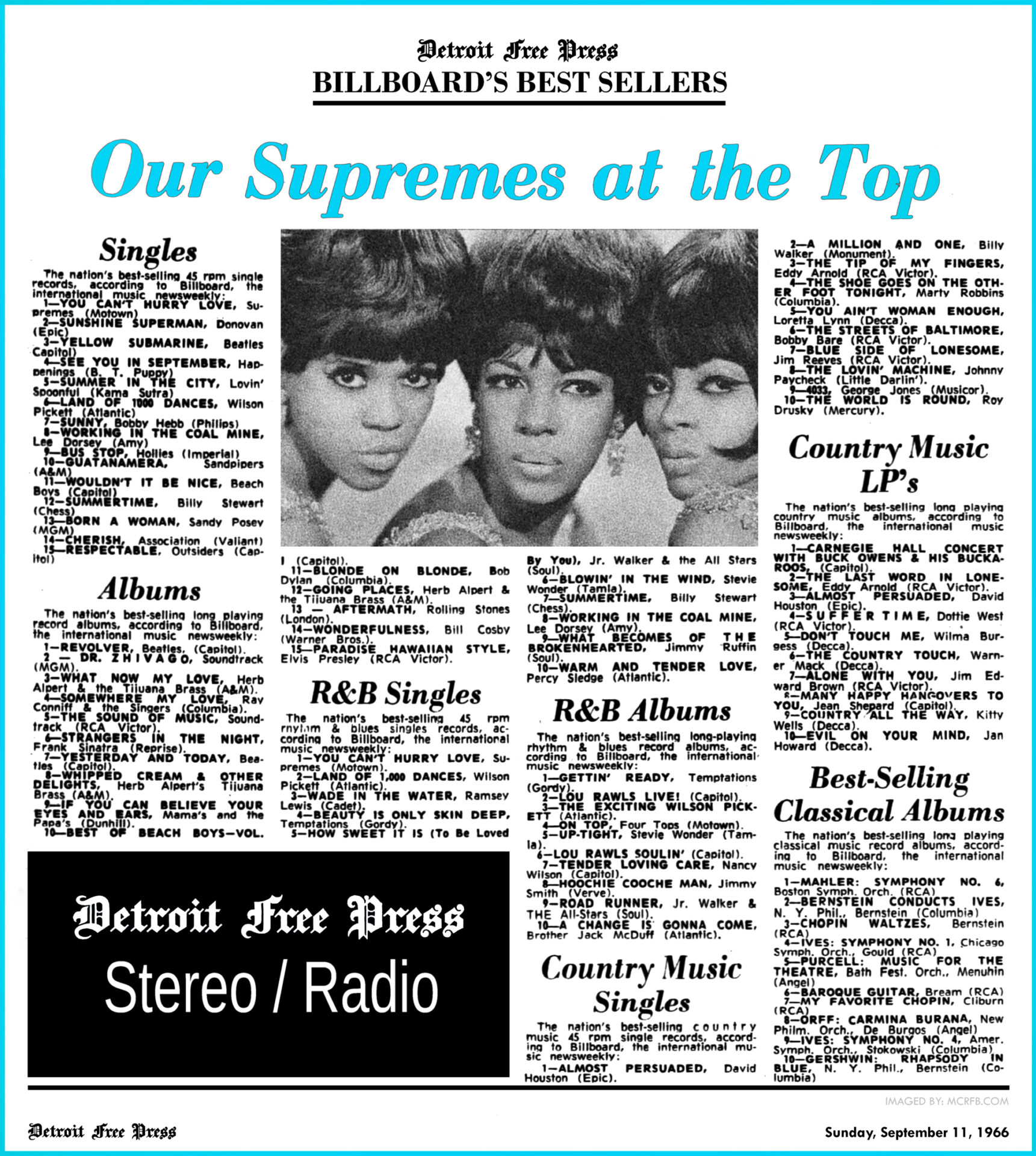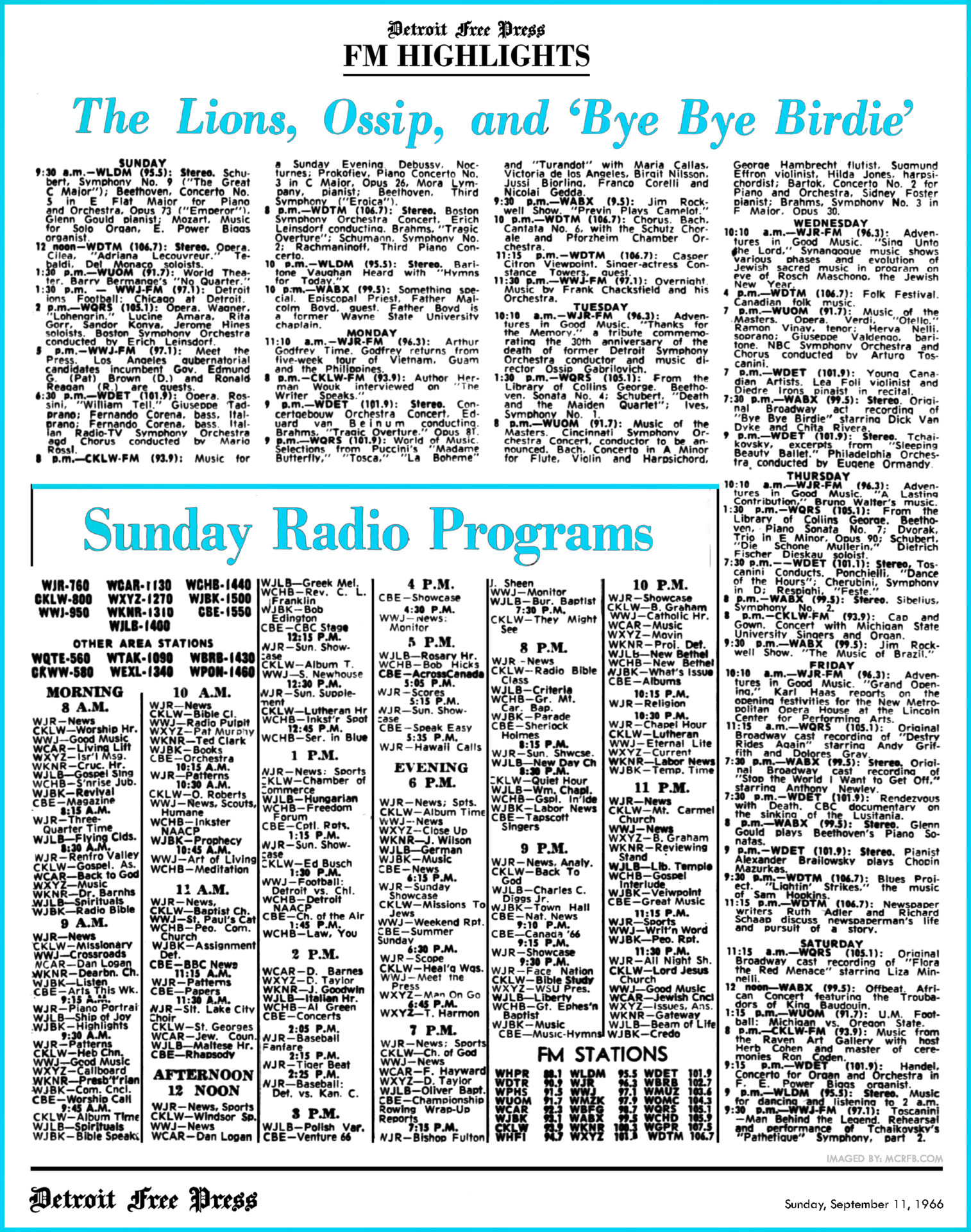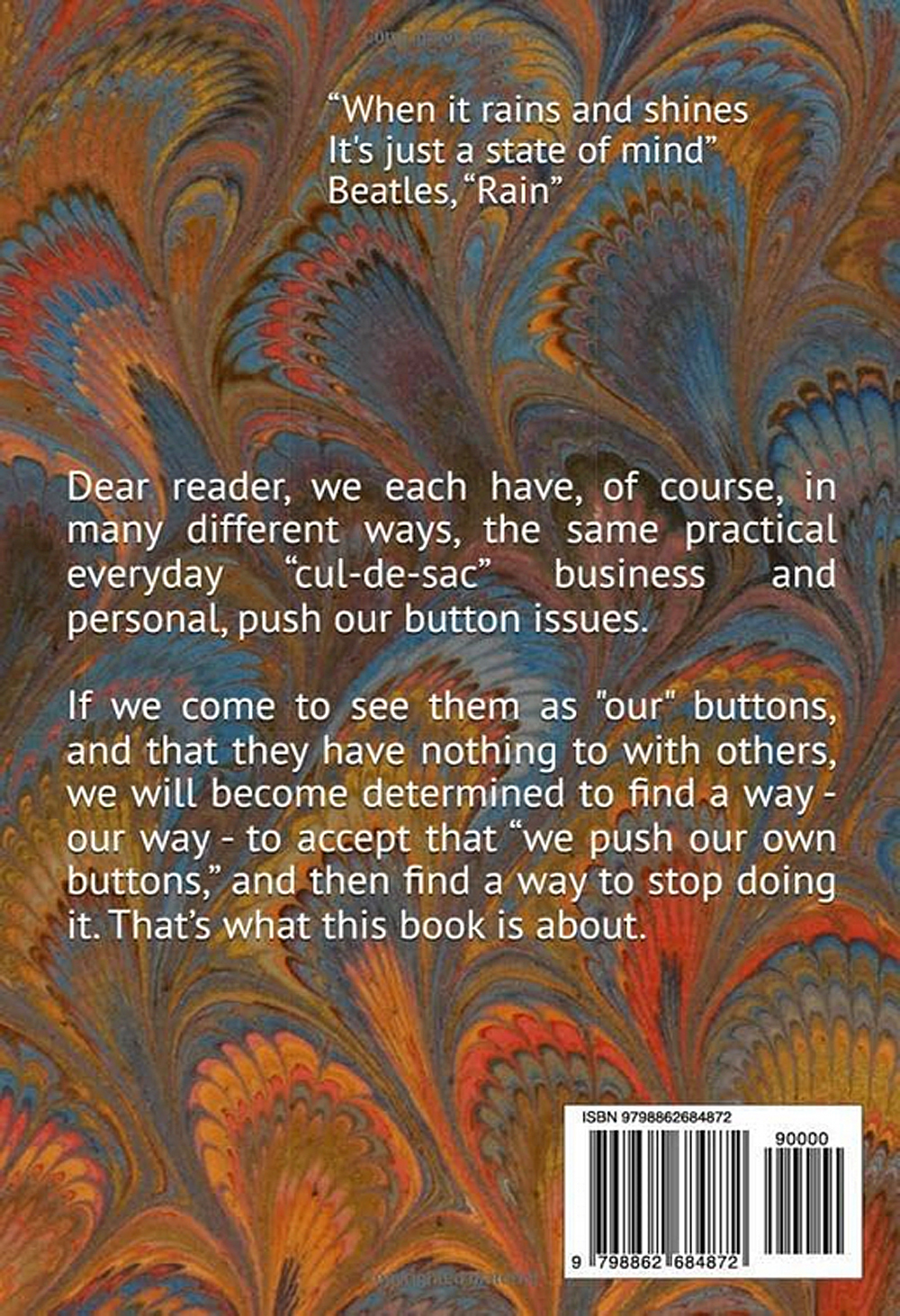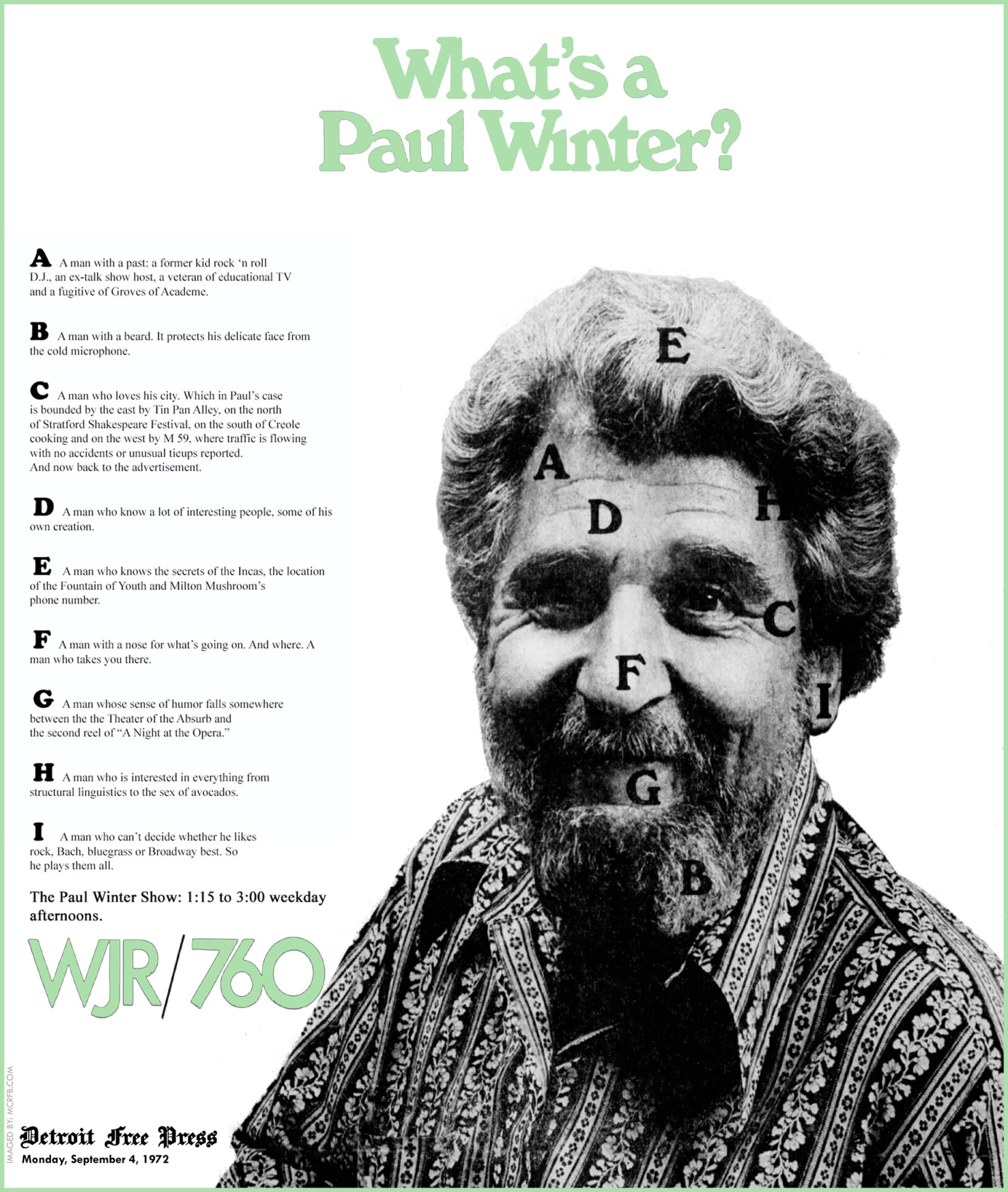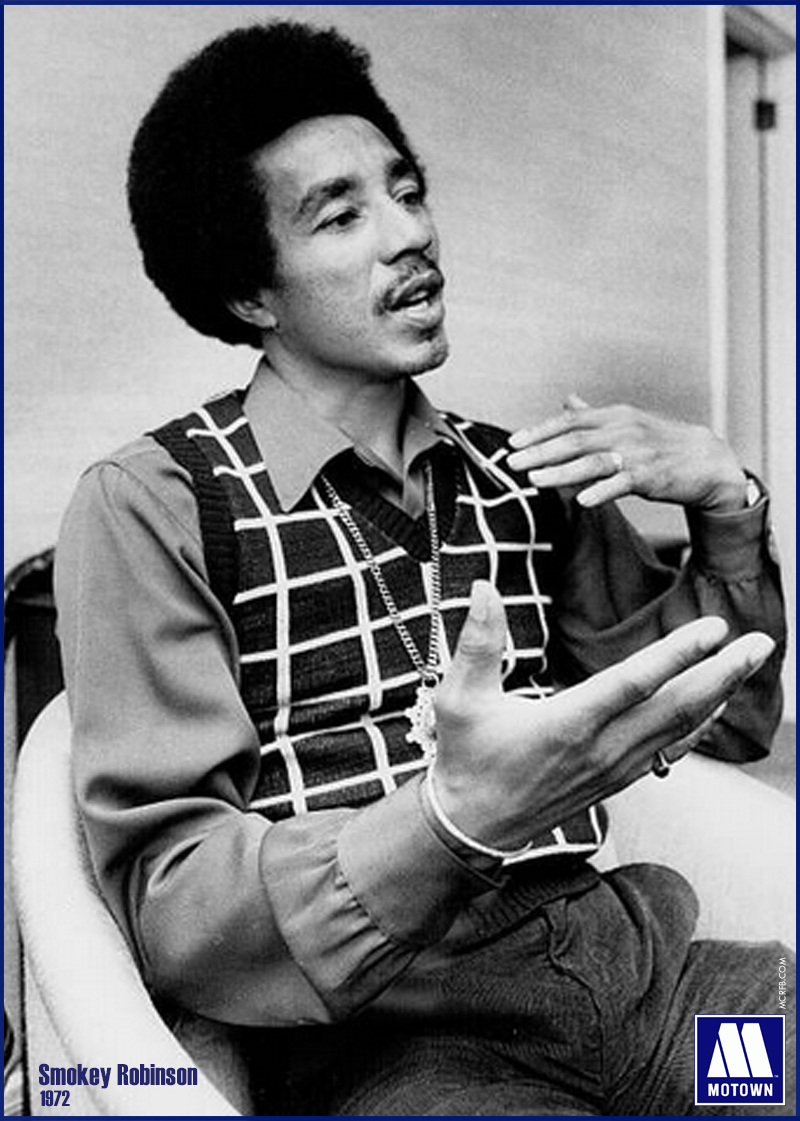![]()
AMERICA: DECADES MEMORIES! A ’71 POP VIDEO REWIND
. . . AND, SHE WAS OUR FELLOW WILSON JR. HIGH STUDENT! WHEN 13 YEAR-OLD CHRISTINE SCHUMACHER WON WKNR ‘RECORD WITH SUPREMES’ CONTEST: NOVEMBER 1966
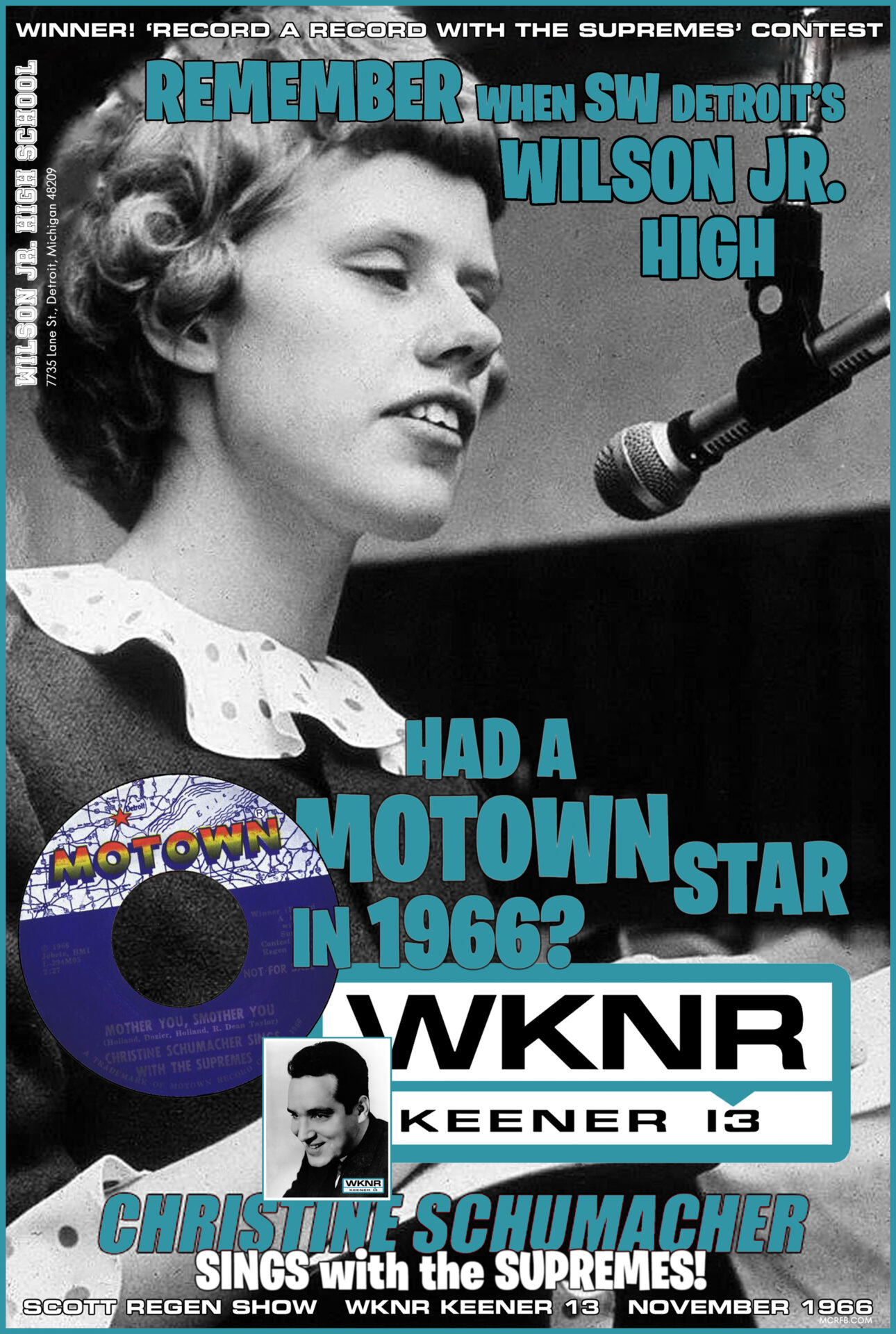
![]()
 Audio digitally remastered by Motor City Radio Flashbacks
Audio digitally remastered by Motor City Radio Flashbacks
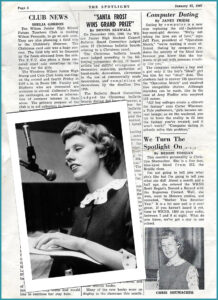
“This month’s personality is Christine Schumacher. She is a five foot, blue-eyed blond from Room 213, the Braille class.
I’m not going to tell you what she’s like but I’m going to tell you what she did! About a month and a half ago, she entered the WKNR Scott Regen‘s ‘Record A Record With The Supremes’ contest. Well, she won, went to Motown Studios, she recorded, “Mother You, Smother You.” It is a hit now and is it ever great.
If you haven’t heard it yet, tune to WKNR, 1300 on your radio, between 7 and 9 at night. What do you know, we’ve got a star in our school!”
![]()
![]()
![]()

![]()
![]()
 Audio digitally remastered by Motor City Radio Flashbacks
Audio digitally remastered by Motor City Radio Flashbacks
![]()
NEW! WTAK [W-TALK] AM1090 BACK ON THE RADIO: PAUL WINTER, 1969

![]()

![]() NEW! Our first WTAK audio inclusion! A special THANK YOU to our friend, Jim Nuznoff, of Port Charlotte, Florida, for this WTAK 1090 contribution (he personally recorded in 1969) for our Motor City Radio Flashbacks airchecks repository.
NEW! Our first WTAK audio inclusion! A special THANK YOU to our friend, Jim Nuznoff, of Port Charlotte, Florida, for this WTAK 1090 contribution (he personally recorded in 1969) for our Motor City Radio Flashbacks airchecks repository.
Jim writes (January 9, 2024) — “This track features Paul Winter, as mid-afternoon host on “W-Talk.” The caller’s voice is that of Tom Morkemo, who was 16 years old, and was a former neighbor of mine whose father was transferred by his employer to the Phillipines for several years. Tom, at the time, prided himself as a young history buff and was trying to impress Winter, in this recording, with his knowledge of current affairs and the world of politics.” –Jim Nuznoff

![]()

![]() Newly restored! This selected audio recording was digitally restored by Motor City Radio Flashbacks.
Newly restored! This selected audio recording was digitally restored by Motor City Radio Flashbacks.

![]()
BILLBOARD’S BEST SELLERS and THE WEEK’S DETROIT RADIO FM HIGHLIGHTS and GUIDE: SEPTEMBER 11, 1966
Above article is courtesy freep.com newspaper archive. Copyright 2024. Newspapers.com.
The above featured newspaper (Detroit Free Press) guides was clipped, saved, and was digitally re-imaged from the credited source by Motor City Radio Flashbacks.
 ON YOUR MOBILE DEVICE? Tap over above DFP newsprint images. Open to second window. “Stretch” print image across your device screen to magnify for largest print view.
ON YOUR MOBILE DEVICE? Tap over above DFP newsprint images. Open to second window. “Stretch” print image across your device screen to magnify for largest print view.
ON YOUR PC? Click on all images 2x for largest print view.
A special thank you to senior MCRFB consultant Greg Innis, of Livonia, MI., for contributing the Newspapers.com archives for articles, ads, and images we have provided for this site since 2016.
Thank you, Greg Innis, for making these historic, Detroit Free Press features possible. 🙂
![]()
CHAPTER SIX | 75 YEARS AGO: THE STATUS of DETROIT RADIO. AS IT WAS . . . AUGUST 1949
 75 Years Ago, August 1, Broadcasting Magazine Reported In-Depth On the Status of the Radio Market in Detroit — Final Chapter – Part 6
75 Years Ago, August 1, Broadcasting Magazine Reported In-Depth On the Status of the Radio Market in Detroit — Final Chapter – Part 6
 Note: Missed Chapter Five? Go HERE.
Note: Missed Chapter Five? Go HERE.
_____________________
Detroit is headquarters for one of the country’s largest producers of TV visual presentations in the Jam Handy Organization. The TV department of this company was set up prior to 1941 by Jamison Handy, president, utilizing all the facilities which had been built up over 30 years in the field of visual training and commercial motion pictures, including production facilities in New York and Hollywood, as well as Detroit.
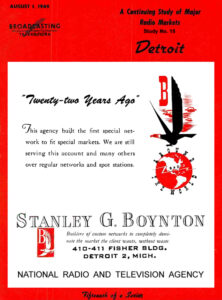
A citation for the “skilled application of commercial techniques to television” was made by the Television Broadcasters Association for the TV commercials of Lucky Strike, produced by the company. In addition, CCNY presented N. W. Ayer & Sons Inc. their 1949 award of merit for creating the most effective spot television announcement. This award was for the Lucky Strike Square Dance commercial produced by Jam Handy. Other Jam Handy TV commercial buyers are Chevrolet, Oldsmobile, Curtis Publishing, Gruen Watch, and Standard Oil of N. J.
All of the Detroit stations except WKMH offer simultaneous FM with AM broadcasts. WWJ-FM is one of the earliest stations in the country. In 1936, it began broadcasting in this medium which was so new that a News editorial said at the time:
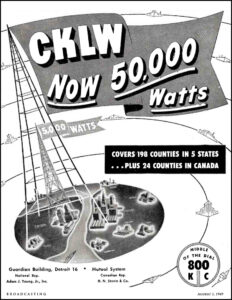 “The News is happy to assist in the revival of a craft which has languished with the perfection of commercial radio sets, the building at home of receivers suited to the new frequencies. A few of these are now manufactured, and their names or advice and plans for the home construction of sets of the same sort, we shall put at the public’s disposal.”
“The News is happy to assist in the revival of a craft which has languished with the perfection of commercial radio sets, the building at home of receivers suited to the new frequencies. A few of these are now manufactured, and their names or advice and plans for the home construction of sets of the same sort, we shall put at the public’s disposal.”
With FM receivers in the Detroit area estimated at 150,000, the three FM-only broadcasters are working hard at their specialized task, using music, news, and especially strong local programming of live talent. WLDM-FM was recently appointed Detroit outlet for the Michigan FM Network, which give it access to a continuing series of concerts from the U. of Michigan, plus the programming of the other 30 FM stations in the network. The Lincoln Broadcasting Co. owns and operates WLDM.
[Note: Mouse click over (pc) or tap and stretch (mobile screen) over the CKLW ad and all images for largest detailed read.]
WDET (FM), which was established in January of this year by the executive board of the UAW-CIO, works closely with many civic groups plus the many auto worker locals. It is especially forward in presenting programs on controversial subjects. During the recent Ford strike, the station offered its facilities to both the company and the union to present their sides of the controversy. Ben Hoberman is station manager.
Strauss Gantz, head of WJJW (FM) in downriver Wyandotte, is another avid supporter of FM, and said this about broadcasting:
“Radio, either FM or AM, without good local programming, serves no public purpose, and becomes either a glorified jukebox or merely a relay point.”
![]()
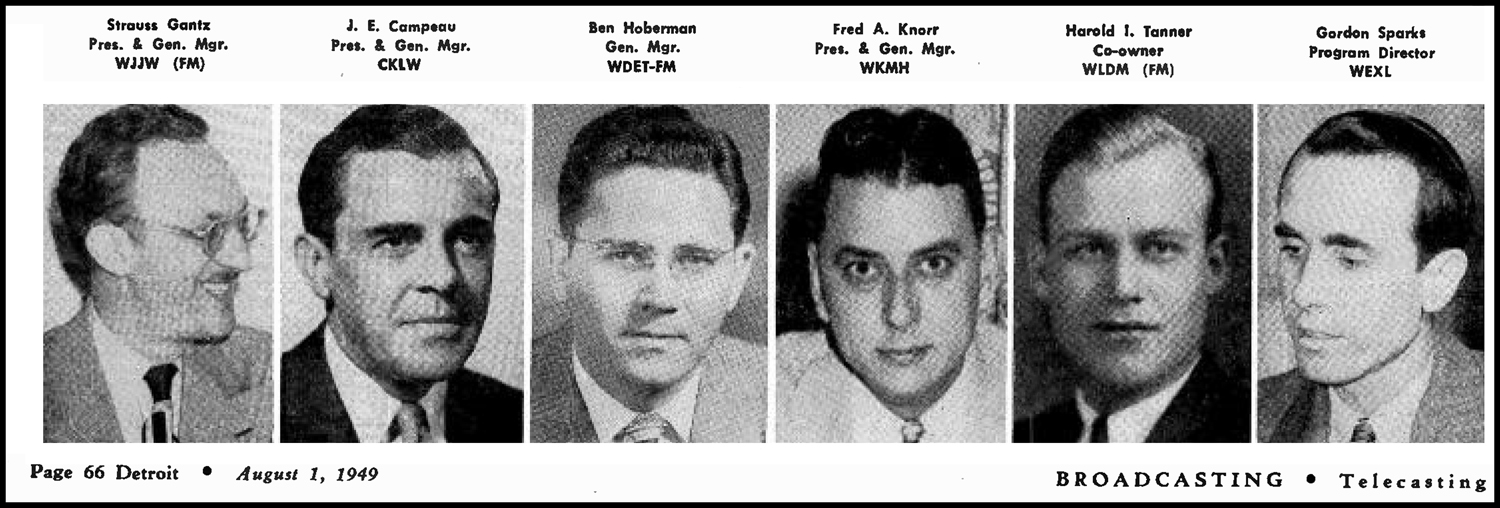
![]() Since Detroit was hooked up to the eastern coaxial cable in January, the growth of television in this area has been rapid. The latest estimate of the number of sets by the Detroit Edison Co. is over 60,000, and TV men confidently expect to hit 100,000 by year-end. The three stations each opened in a blaze of publicity, getting editorial and advertising support from the Detroit newspapers, each of which put out a TV section at different times. Advertisers, especially the key auto men, have been eager to try to do a good selling job via the new medium.
Since Detroit was hooked up to the eastern coaxial cable in January, the growth of television in this area has been rapid. The latest estimate of the number of sets by the Detroit Edison Co. is over 60,000, and TV men confidently expect to hit 100,000 by year-end. The three stations each opened in a blaze of publicity, getting editorial and advertising support from the Detroit newspapers, each of which put out a TV section at different times. Advertisers, especially the key auto men, have been eager to try to do a good selling job via the new medium.
![]()
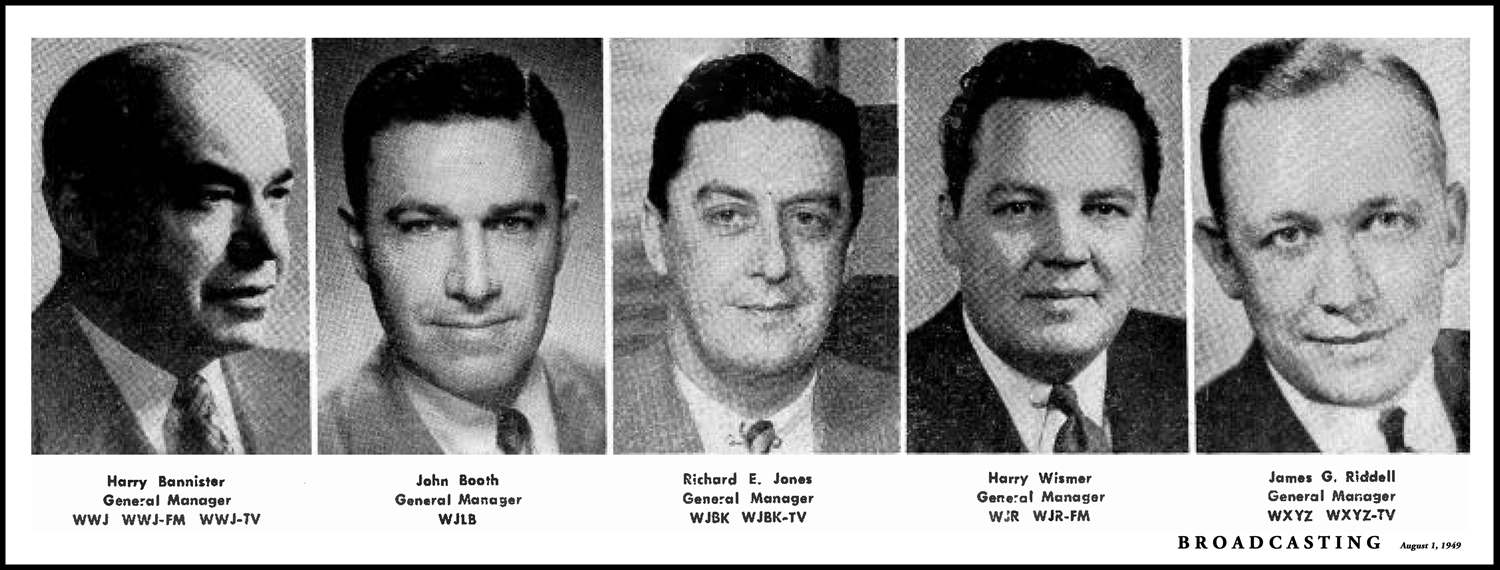
![]() All four TV networks are represented in Detroit. WWJ-TV is outlet for NBC, WXYZ-TV for ABC, and WJBK-TV handles DuMent and CBS. There is FCC authorization for another channel, with several applications pending.
All four TV networks are represented in Detroit. WWJ-TV is outlet for NBC, WXYZ-TV for ABC, and WJBK-TV handles DuMent and CBS. There is FCC authorization for another channel, with several applications pending.
As expected, the auto men jumped into television with the opening of the first station in the city. The fact that here was a way of actually showing the product along with a spoken sales talk caused a rush to TV by both local dealers and national companies. One station, WXYZ-TV, had an eight-foot opening cut into its studio wall so automobiles could be driven directly onto the stage for commercials. END
_____________________
MCRFB Note: This chapter finalizes The Detroit Radio Market report (presented here in six parts) first published by Broadcasting, August 1, 1949.
 This article will conclude our weekly special series on Detroit radio from Broadcasting magazine, from August 1, 1949.
This article will conclude our weekly special series on Detroit radio from Broadcasting magazine, from August 1, 1949.
This feature was a special Broadcasting series about Detroit radio, first published, August 1, 1949. The complete article was republished on this site, Tuesdays, throughout August and September for a total of six weeks.
Originally published in Broadcasting magazine under the title “The Detroit Radio Market,” this extensive article was presented in full in six parts, in sequential chapters.
The 1949 article provides valuable insights into the state of radio in Detroit during the late 1940s decade, as it was, then, seven decades ago.
![]()
SCOTT REGEN! TODAY and NOW: ‘WHEN SOMETHING PUSHES YOUR BUTTON, IT’S YOUR BUTTON’ AVAILABLE NOW on AMAZON BOOKS

Swami Ramananda, Executive Director, “Integral Yoga Institute,” San Francisco.

This book invites us to forge our own paths by exploring traditional Eastern spiritual teachings that offer empowering insights. It promotes the development of self-confidence, inner peace, love, and satisfaction in our daily lives, despite the inevitable ups and downs, by addressing and transforming past karmic influences that trigger our reactions. If the messages in John Lennon’s “Instant Karma” and “Imagine,” as well as Paul McCartney’s lyrics, “And in the end, the love you take is equal to the love you make,” resonate with you, you’ll likely find that the wisdom and passages in this book will similarly speak to you, just as they did to me with every page I turned. — Jim Feliciano
 Reading it now! Wonderful book! It’s a heartfelt compilation Unlike any other spiritual book. Serious yet I have to chuckle as I’m reading. Thank you for sharing your amazing work with us. Namaste — NYC Lady
Reading it now! Wonderful book! It’s a heartfelt compilation Unlike any other spiritual book. Serious yet I have to chuckle as I’m reading. Thank you for sharing your amazing work with us. Namaste — NYC Lady
 The answer to many of life’s questions are complicated and sometimes mysterious. This book challenges, your own mind to look beyond the window And see the outside. The authors background as a former radio personality, allows him to intersperse the magical art of music and the stories that the lyrics reveal. It’s truly an enlightening read. Sometimes heavy…. Sometimes humorous, but always thought provoking. I am reading it for the second time which I guess is a testament to its excellence. — Jim Davis (formerly Big Jim Edwards, CKLW)
The answer to many of life’s questions are complicated and sometimes mysterious. This book challenges, your own mind to look beyond the window And see the outside. The authors background as a former radio personality, allows him to intersperse the magical art of music and the stories that the lyrics reveal. It’s truly an enlightening read. Sometimes heavy…. Sometimes humorous, but always thought provoking. I am reading it for the second time which I guess is a testament to its excellence. — Jim Davis (formerly Big Jim Edwards, CKLW)
![]()
WJR RADIO 760: PAUL WINTER [Detroit Free Press] DETROIT RADIO BACK-PAGE AD . . . SEPTEMBER 4, 1972
This article/advertisement courtesy freep.com newspaper archive. Copyright 2024. Newspapers.com
Originally printed in black and white, the featured Detroit Free Press ad was digitally re-imaged, colorized, and was entirely restored by Motor City Radio Flashbacks.
Missed any of our previous ‘Detroit Radio Back-Pages‘ features? GO HERE

![]()
 MCRFB Note: Special THANKS to our friend, John Bartony (a.k.a. Jukebox John) St. Clair Shores, Michigan, for providing the above Detroit Free Press WJR 760 ad (September 1972) for this site, as featured today.
MCRFB Note: Special THANKS to our friend, John Bartony (a.k.a. Jukebox John) St. Clair Shores, Michigan, for providing the above Detroit Free Press WJR 760 ad (September 1972) for this site, as featured today.
 A special thank you to senior MCRFB consultant Greg Innis, of Livonia, MI., for contributing the Newspapers.com archives (Detroit radio related) articles, ads, and images we have provide for this site since 2016.
A special thank you to senior MCRFB consultant Greg Innis, of Livonia, MI., for contributing the Newspapers.com archives (Detroit radio related) articles, ads, and images we have provide for this site since 2016.
Thank you, Greg Innis, for making these historic Detroit radio features possible. 🙂

![]()
 ON YOUR PC? You can read this entire newsprint article/ad — the fine print — ENLARGED. For a larger detailed view click above image 2x and open to second window. Click image anytime to return to NORMAL image size.
ON YOUR PC? You can read this entire newsprint article/ad — the fine print — ENLARGED. For a larger detailed view click above image 2x and open to second window. Click image anytime to return to NORMAL image size.
Click your server’s back button to return to MCRFB.COM home page.
ON YOUR MOBILE DEVICE? Tap on newsprint image. Open to second window. “Stretch” image across your device screen to magnify for largest print view.

![]()
CHAPTER FIVE | 75 YEARS AGO: THE STATUS of DETROIT RADIO. AS IT WAS . . . AUGUST 1949
 75 Years Ago, This Month, Broadcasting Magazine Reported In-Depth On the Status of the Radio Market in Detroit — Part 5
75 Years Ago, This Month, Broadcasting Magazine Reported In-Depth On the Status of the Radio Market in Detroit — Part 5
Note: Missed Chapter Four? Go HERE.
_____________________
Rather than buck the heavy advertising in the Thursday afternoon papers, he advised them to put their money in spots around the Breakfast Club hour, three of which were open. Avoiding price, for their quality foods couldn’t compete with the chains on that basis, the spots stressed just one special all week, with a reference to the convenience of “shopping where you work.” Each booth was to be featured for a week. Results were so good that the market has just signed to take two spots in the fall around the Kate Smith show, in addition to the regular purchase.
The Twin Pines Dairy, a cooperatively owned client of Luckoff, Wayburn & Frankel, has the Dr. Crane health program daily over WXYZ. Lately, the dairy has bought TV spots.
D & C Steamship Lines uses a heavy schedule of spots during the operating season on larger stations to promote excursions and cruises. WJR gets a large share of this business, aimed at tourist traffic from all over the Midwest. Another successful radio user is Cole & Irwin Co., buying 10 spots daily to sell jewelry and radios.
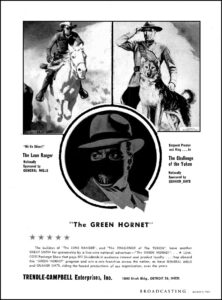 Boyer’s Haunted Shacks, a chain of auto accessory stores, embarked on a saturation spot program on one station, WJBK, featuring an eerie squeaking door commercial, and the copy, “High prices don’t have a ghost of a chance at Boyer’s.” Mr. Luckoff says the chain has had remarkable success. Other leading L -W -F accounts are T. L. Grissom, local Chevrolet dealer, who broadcasts horse races from Detroit’s Fair Grounds; Detroit Ice Assn., using TV spots to promote use of ice; Progress Bedding Co., maker of Rest -O -Craft mattresses, using chain breaks around high Hooter rated shows; Wolverine Potato Chips, with participation shows: and Borin Ice &. Fuel, using TV spots.
Boyer’s Haunted Shacks, a chain of auto accessory stores, embarked on a saturation spot program on one station, WJBK, featuring an eerie squeaking door commercial, and the copy, “High prices don’t have a ghost of a chance at Boyer’s.” Mr. Luckoff says the chain has had remarkable success. Other leading L -W -F accounts are T. L. Grissom, local Chevrolet dealer, who broadcasts horse races from Detroit’s Fair Grounds; Detroit Ice Assn., using TV spots to promote use of ice; Progress Bedding Co., maker of Rest -O -Craft mattresses, using chain breaks around high Hooter rated shows; Wolverine Potato Chips, with participation shows: and Borin Ice &. Fuel, using TV spots.
Note: Mouse click over (pc) or tap and stretch (mobile screen) over the WXYZ ad image for largest detailed read.]
In addition to Industrial National Bank, radio has been used by practically all of the institutional and utilities advertisers in Detroit. Commonwealth Bank, through Ted Reeves, of Toledo, is a long-time user of spots.
Detroit Edison Co., electric power supplier to Detroit and suburbs, uses the H.C.L. Jackson (Detroit News columnist) show, and was one of the first TV sponsors in the area, with its Kitchen Carnival show on WWJ-TV. It has another TV show, the Jane Durelle Story Book, a children’s program five times a week. This is in keeping with the utility’s policy of spending 90% of its budget in goodwill and public service programs. The only sales effort now going on is a spot, campaign throughout southeastern Michigan on electric water heaters. Campbell-Ewald is agency for Edison.
Fred Randall Co. places the Michigan Consolidated Gas Co. sponsorship of the Lee Smits newscast over WXYZ. Though the bulk of Bell Telephone time is placed in New York, the Detroit office retains a measure of supervision over local programs.
It is a doubtful honor in the ears of many, but Detroit claims credit for the origination of the singing jingle. In 1928 Cliff MacDonald, of the coal company bearing his name, in looking for something different for his ads, hit upon the idea of making up a short song to be used in spot radio. He wrote the words to a tune composed by a Detroit pianist, Carl Rupp, and “MacDonald for coal, MacDonald for coke, MacDonald for quality fuel” was introduced by Russ Morgan’s orchestra, then active in Detroit. The tune caught on, and for years Mr. MacDonald was saluted with it whenever he entered a club or dance. It is still used in spots. Neff Radio Productions is the agency.
The position as oldest consistent advertiser on WJR goes with no opposition to the Ohio China Co. of Monroe, Mich. Using participations on the station’s Mrs. Page show, this company has used two spots per week for 18 years, renewing each year, and going through three different Mrs. Pages in that time. Finzel Agency of Monroe handles the billing. Two of the largest spot buyers in the city are Speedway Petroleum Corp. and Federal Department Stores. Both of these 1,000 or more spots-per-year buyers are handled by W. B. Doner & Co. Though a reluctant radio user at first, Speedway Gasoline now puts ‘75% of its budget into radio and is planning a TV show for fall. The King’s Jesters’ singing commercial, “Speedway’s Goin’ Steady With Ethyl,” has aroused many favorable comments.
Federal has had a 1,000 spot-per-year contract for the past five years, and formerly sponsored a local AM amateur show for seven years. With 12 stores in the Detroit area, Federal is planning a super-saturation in August, preliminary to opening a new store; 150 AM spots a day will be used and 30 TV, for two weeks. A preview, complete with columnists, representatives of national manufacturers and Powers models for color, will be telecast. W. B. Doner is president of the company, with Charles F. Rosen as executive vice president. They handle the bulk of the agency’s radio accounts.
Another brewer with a big radio and TV budget is E & B. This company, through the Doner agency, has been placing a third of its budget in air time, and is sponsoring Tuesday night wrestling matches, with a Friday wrestling show scheduled to start in a few weeks. In addition, it is using 20 time report spots per day on WJBK, and has spots running continuously in 10 out-state markets.
Other prominent Doner accounts are: Annis Furs, now buying eight spots per week on major stations, heavier during fur storage season; Enggass Jewelers, one of the oldest spot buyers in Detroit; Faygo Beverages, buying top spot and chain breaks when available; Detroit Retail Druggists Assn., which has five and 15-minute shows on four major stations simultaneously. Doner also prepares copy for the Big Bear chain of super markets, planning radio and TV shows later in the year.
Harry Betteridge, who resigned as general sales manager of WWJ and WWJ -TV in April to form the firm, of Denman & Betteridge, with Willian I. Denman, is another radio and television veteran in Detroit. In lining up sponsors for WWJ-TV, Mr. Betteridge was selling television a year-and-a-half before the first Detroit telecast.

Michigan Mutual Insurance Co. is one of the agency’s principal accounts, using spots 52 weeks a year on 25 stations in five states. Another outstanding effort was that of the Thomas J. Doyle Co., a Dodge-Plymouth dealer, in promoting its Glitter-Glaze, an automobile polish. Through a strong spot campaign over 17 years, it was able to make Glitter-Glaze a common noun in the city, a la Simoniz. Detroit and Toledo Philco distributors last year used nine half-hours per week on television, one of the heaviest TV buys in the U. S. Other active accounts of Denman & Betteridge are Silvercup Bread (Gordon Baking Co.) and New Era Potato Chips. The agency also places the DeSoto Dealers of Detroit business, a buy of telecasting rights to the horse races.
No history of Detroit radio would be complete without recounting the story of The Lone Ranger. This tremendously popular program, with two others, The Green Hornet and Challenge of the Yukon, was created and developed by George W. Trendle, who is now president of Trendle-Campbell Enterprises. Mr., Trendle entered radio in 1930, buying station WXYZ, and operating it with his theatre business associate, John H. King. The firm was then known as the King-Trendle Broadcasting Corporation.
Beginning in 1933, during the depression, the program was a hit from the start. Gordon Baking Co. (Silvercup Bread) began sponsorship in November of that year, and continued until 1941. Now in its seventeenth consecutive year of broadcasting, The Lone Ranger has established a world record for half-hour radio dramas. The show started on a three times a week basis in its first year, and continued without interruption until the death of FDR caused the first cancellation. Since 1941, sponsorship in most areas of the country has been by General Mills for their Brix, Cheerios and Pyequick, through Dancer, Fitzgerald-Sample. In the South and Southeast, the program is sponsored by Marita Bread, through Tucker, Wayne & Co., based in Atlanta, Ga.
The other half of the partnership is H. Allen Campbell, vice-president and general manager of T-C Enterprises, who went to the sales staff of WXYZ in 1930 from a Detroit newspaper. Within six months he was sales manager of the corporation. It was he who first sold The Lone Ranger as a network program, first with NBC Blue, then with ABC. Made general manager of Trendle-Campbell in 1933, he became vice president in 1946, when the firm began to be known as Trendle-Campbell Enterprises. In 1936, Trendle created The Green Hornet, still carried weekly by ABC as a sustaining program. Challenge of the Yukon, latest of the Trendle Trio, is currently being sponsored three times weekly by Quaker Oats Co., through Sherman & Marquette, Chicago. The company also owns and operates WTAC Flint, Michigan. MCRFB: to be continued next week . . . .
 This feature is a special Broadcasting series about Detroit radio. This was first released by the publication on August 1, 1949. It will continue as an exclusive presentation every Tuesday on this site throughout August and in the first and second two Tuesday in September, for a total of six weeks.
This feature is a special Broadcasting series about Detroit radio. This was first released by the publication on August 1, 1949. It will continue as an exclusive presentation every Tuesday on this site throughout August and in the first and second two Tuesday in September, for a total of six weeks.
Originally published in Broadcasting magazine under the title “The Detroit Radio Market,” this extensive article will be presented in six parts, continuing in sequential chapters.
The 1949 article provides valuable insights into the state of radio in Detroit during the late 1940s decade, as it was, then, seven decades ago.
![]()
MOTOWN MONDAY! A Detroit Free Press NEWSPRINT BACK-PAGE: SMOKEY ROBINSON HEADS WEST
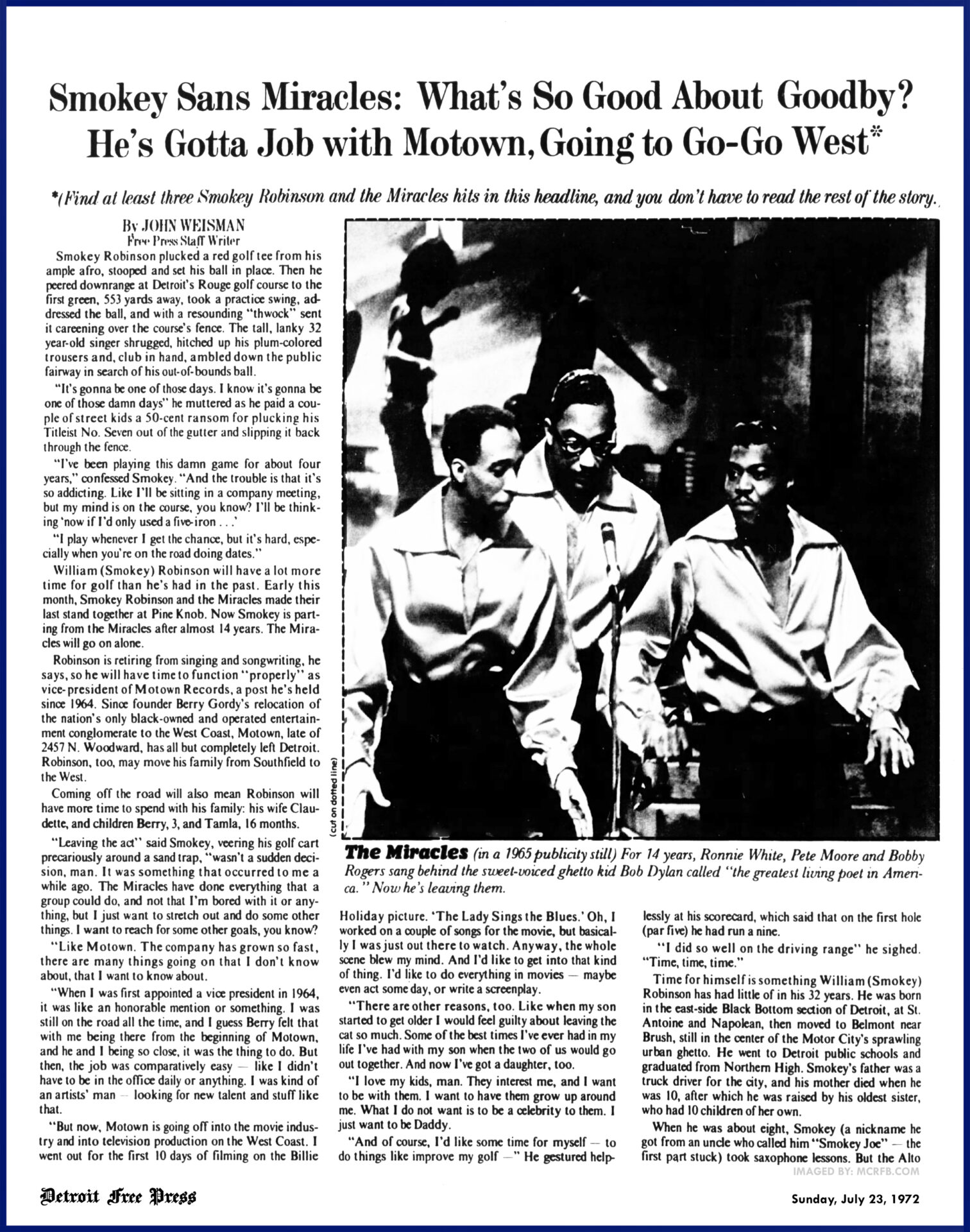
![]()
![]()
 Above article is courtesy freep.com newspaper archive. Copyright 2024. Newspapers.com.
Above article is courtesy freep.com newspaper archive. Copyright 2024. Newspapers.com.
The above featured ‘Motown’ newspaper article (Detroit Free Press) was clipped, saved, and was digitally re-imaged from the credited source by Motor City Radio Flashbacks.
“If everybody will keep on remembering, keep the music alive, our children and grandchildren will know what this was.” — Claudette Robinson, November 21, 2009
Motown 50 Ball Golden Gala, Detroit Marriott, Det., MI.
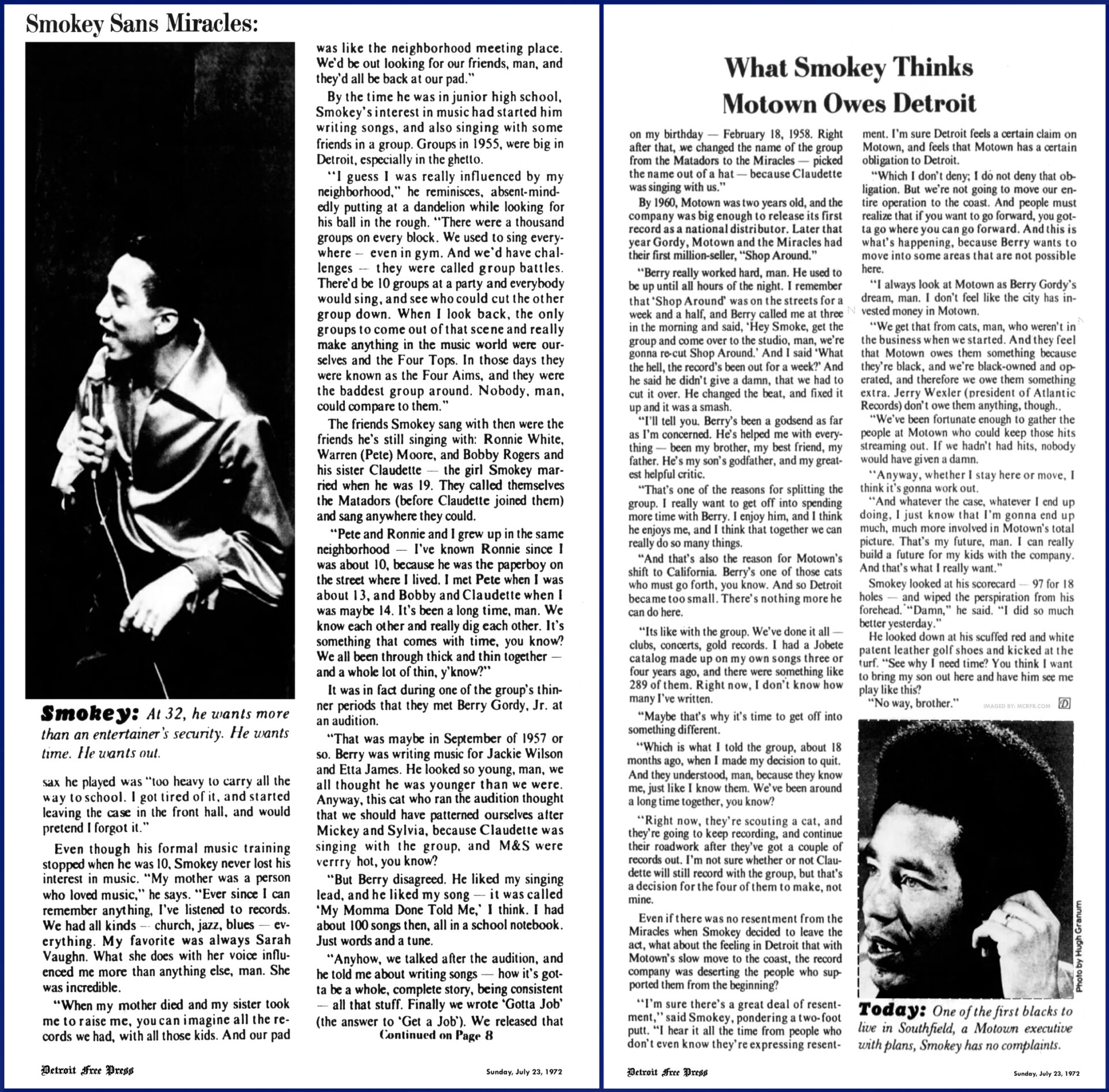
![]()
![]() ON YOUR MOBILE DEVICE? Tap over above DFP newsprint image. Open to second window. “Stretch” print image across your device screen to magnify for largest print view.
ON YOUR MOBILE DEVICE? Tap over above DFP newsprint image. Open to second window. “Stretch” print image across your device screen to magnify for largest print view.
ON YOUR PC? Click on all images 2x for largest print view.
A special thank you to senior MCRFB consultant Greg Innis, of Livonia, MI., for contributing the Newspapers.com archives (Motown related) articles, ads, and images we have provided for this site since 2016.
Thank you, Greg Innis, for making these historic, Detroit Free Press features possible. 🙂
![]()
















